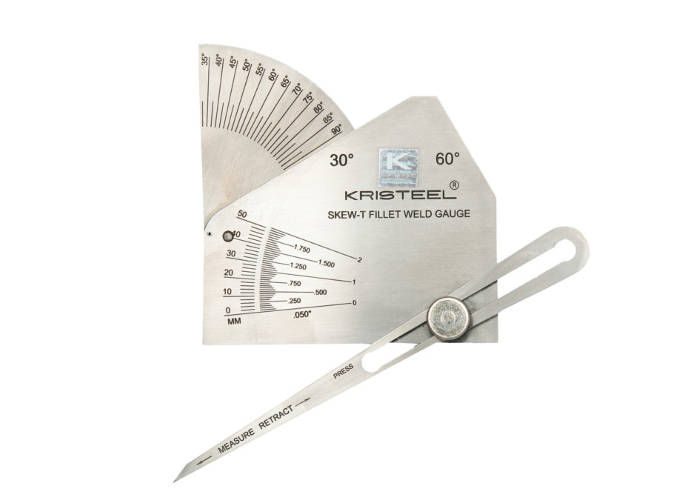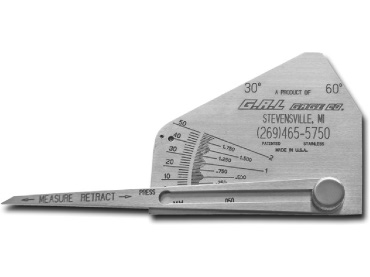Innovative Strategies to Fillet Weld Evaluation and Screening: Enhancing Weld High Quality and Conformity Requirements
In the world of welding, the quality and stability of fillet welds play a critical role in making sure the architectural sturdiness and reliability of various commercial parts. With the consistent drive for boosted performance and compliance with stringent requirements, the exploration of ingenious techniques to fillet weld assessment and screening has ended up being imperative. As industries evolve, the standard methods may no much longer suffice in satisfying the demands of modern welding applications (Gauge Fillet Weld). By welcoming advanced technologies and methodologies, a new horizon of possibilities arises in the world of weld high quality evaluation and adherence to conformity requirements.
Advanced Non-Destructive Testing Techniques
Utilizing advanced modern technologies, progressed non-destructive testing techniques play an important duty in ensuring the honesty and quality of fillet welds. These approaches, such as phased selection ultrasonic screening (PAUT) and magnetic fragment testing (MPT), offer detailed understandings right into the weld's internal framework without causing any kind of damage to the material. PAUT, as an example, uses numerous ultrasonic elements to evaluate the weld from different angles, giving an extensive visualization of prospective defects like absence of fusion or splits.
In A Similar Way, MPT is efficient in spotting surface-breaking flaws by using a magnetic field and iron bits to the weld location. This approach is especially useful for determining discontinuities that may compromise the weld's strength. By employing these sophisticated non-destructive testing strategies, weld inspectors can accurately evaluate the quality of fillet welds, making certain compliance with industry requirements and regulations. The ability to discover problems early on not just enhances weld top quality however additionally prevents costly rework or failures in structural stability, underscoring the value of these innovative testing methods in welding assessments.
Robotics and Automation in Examination

The assimilation of robotics and automation has actually transformed the inspection procedure for fillet welds, improving efficiency and precision in quality assessment. Robotics supply exact control and repeatability in examining welds, making sure regular and trustworthy results. Automated systems can be programmed to adhere to particular assessment paths, making certain complete protection of welds and minimizing the risk of human mistake.
Robotic examination systems geared up with sophisticated sensing units can identify and determine weld attributes with high precision, supplying in-depth information for evaluation. These systems can recognize issues such as cracks, absence of combination, and porosity, making it possible for prompt restorative activities to be taken. In addition, robotics and automation enable real-time data collection and analysis, providing instant responses to drivers and helping with fast decision-making procedures.
Furthermore, using robotics and automation in fillet weld assessment boosts general performance by reducing examination times and increasing evaluation throughput. By enhancing the assessment procedure, makers can make certain weld top quality and conformity criteria are met effectively, eventually causing cost financial savings and boosted item high quality.
Using Artificial Knowledge for Evaluation
Expert system plays a critical role in enhancing the efficiency and accuracy of analysis in fillet weld inspection procedures. By using the power of AI, assessors can simplify the analysis of weld quality and conformity requirements, resulting in much more precise and trusted outcomes. AI algorithms can quickly process vast quantities of data from weld inspections, spotting defects or incongruities that may be challenging to understand the naked eye. This advanced modern technology makes it possible for real-time tracking of weld quality, enabling instant corrective activities to be taken if any concerns are detected.
Additionally, AI systems can gain from past assessment data, continuously boosting their ability to recognize potential problems and inconsistencies in fillet welds. This flexible discovering capacity boosts the overall quality control process, lowering the possibility of human error and making certain that welds meet the needed criteria. By incorporating expert system right into fillet weld evaluation, markets can achieve higher levels of efficiency, consistency, and compliance in their assessment techniques.
Portable Devices for On-Site Evaluation
Enhancing field assessment effectiveness, the adoption of portable devices revolutionizes on-site assessment procedures for fillet welds. These tools use adaptability and ease, allowing examiners to carry out thorough assessments in different areas, consisting of remote or tough environments. Portable devices such as ultrasonic screening gadgets, magnetic fragment assessment devices, and digital radiography systems offer have a peek at this site real-time data and high-resolution imaging abilities, enabling quick decision-making and prompt responses on weld high quality.
One considerable benefit of mobile devices is their capability to improve assessment procedures, decreasing downtime and enhancing overall efficiency - Gauge Fillet Weld. Inspectors can conveniently move these devices to various task websites, getting rid of the need for transferring hefty equipment or components to off-site centers. Furthermore, the portability of these devices promotes cost-effectiveness by minimizing transport costs and speeding up examination timelines
Additionally, making use of mobile tools for on-site inspection advertises proactive top quality control measures, as assessors can immediately identify and attend to any kind of possible welding defects or disparities. By integrating these innovative modern technologies into on-site examination methods, welding professionals can make sure compliance with market criteria and enhance weld top quality, ultimately causing boosted architectural integrity and security in numerous welding applications.
Integration of Information Administration Equipment

Having actually optimized on-site evaluation procedures via the use of portable tools, the following phase includes the smooth combination of data monitoring systems to further boost effectiveness and data evaluation capabilities in fillet weld evaluation and screening. By integrating data monitoring systems right into the evaluation procedure, organizations can streamline data collection, storage space, and analysis. This combination permits real-time tracking of weld top quality, immediate recognition of flaws, and timely decision-making to rectify any type of issues that may occur throughout the examination procedure.
The combination of information administration systems allows smooth interaction in between various stakeholders included in the inspection process, fostering collaboration and boosting overall top quality control measures. Eventually, the integration of data management systems offers to raise the requirements of fillet weld examination and screening, ensuring conformity with market guidelines and improving weld high quality.
Conclusion
In verdict, cutting-edge approaches to fillet weld examination and screening have significantly improved weld quality and conformity standards. Advanced non-destructive screening approaches, robotics, automation, expert system, mobile devices, and data management systems have actually reinvented the method weld evaluations are conducted. By making use of these innovations, look at more info sectors can make certain that welds satisfy the called for high quality standards and regulations, eventually improving general efficiency and safety and security in welding processes.

Having actually enhanced on-site examination procedures with the utilization of portable tools, the following phase involves the smooth integration of information monitoring systems to additionally enhance performance and data analysis capabilities in fillet weld examination and testing. Ultimately, the assimilation of information monitoring systems serves to boost the requirements of fillet weld evaluation and screening, making certain compliance with industry regulations and boosting weld quality.

Comments on “Gauge Fillet Weld Explained: From Basics to Advanced Techniques”